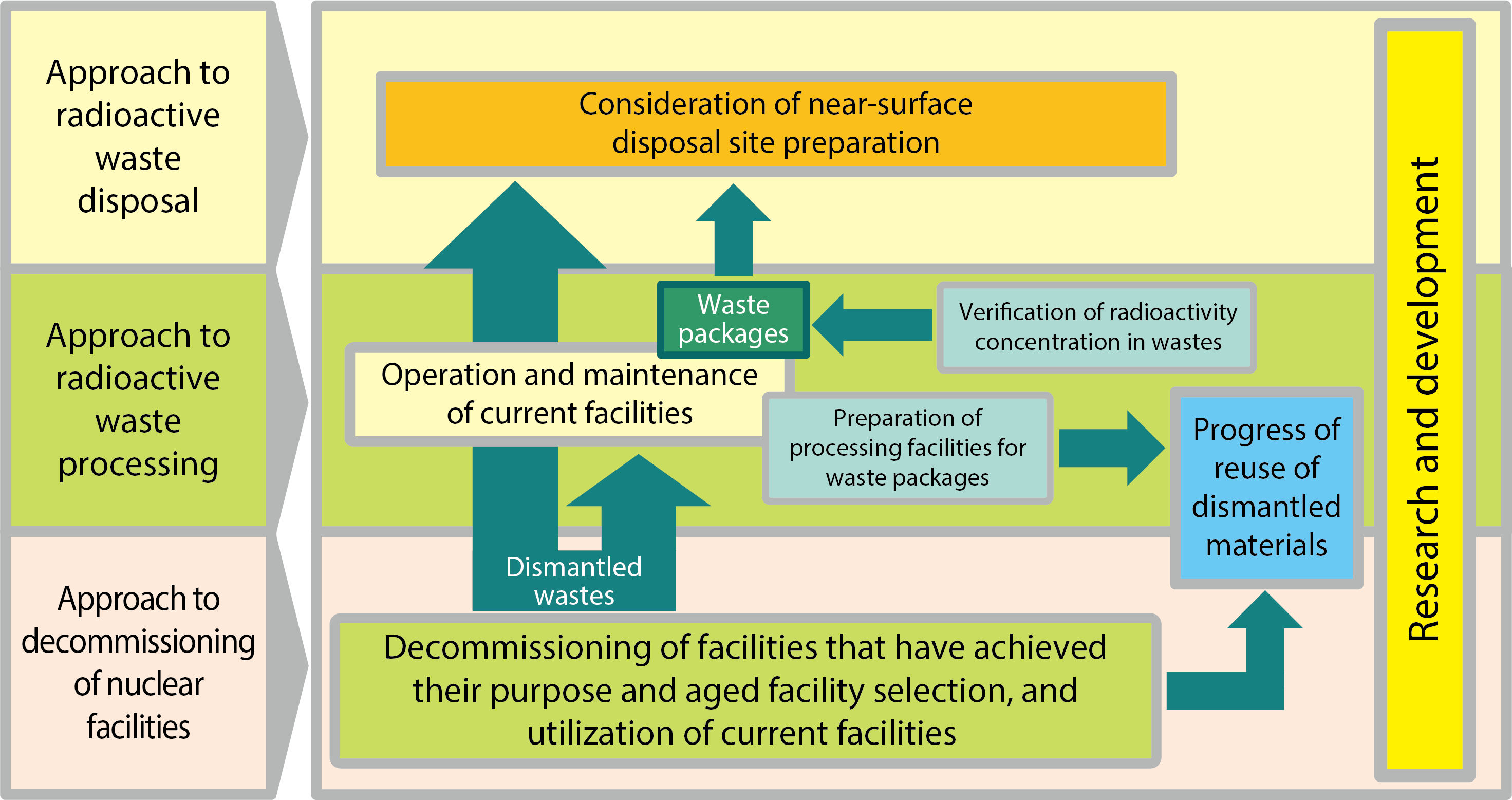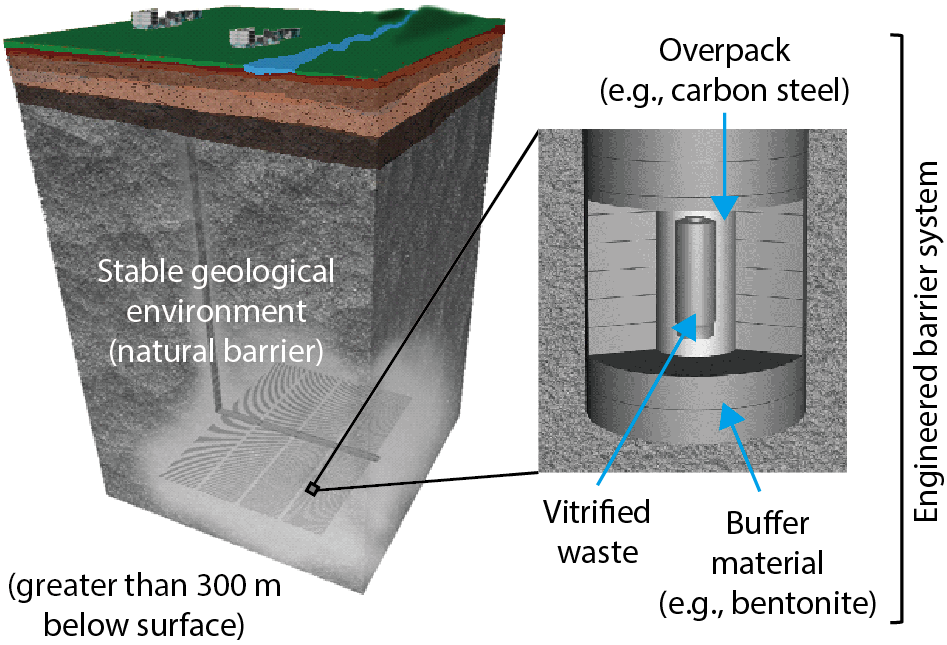
Fig.8-1 Outline of low-level radioactive waste management

Fig.8-2 Schematic view of the basic concept for the geological disposal of high-level radioactive waste in Japan

Fig.8-3 Structure of JAEA R&D activities
Toward the Decommissioning of Nuclear Facilities and Radioactive Waste Management
JAEA formulated the “Medium- and Long-Term Management Plan of our Facilities” (issued on April 1, 2017, amended on April 1, 2018) as a comprehensive plan which detailed the following three points:
– Selection and consolidation of facilities,
– Safety measures,
– Management of back-end issues.
In the plan, 44 nuclear facilities were chosen to be decommissioned.
JAEA submitted an application for the permission to proceed with the decommissioning of MONJU and the Tokai Reprocessing Plant (TRP) to the Nuclear Regulation Authority (NRA), which led to NRA granting this permission for MONJU on March 28, 2018, and for TRP on June 13, 2018.
To ensure a safe and appropriate nuclear facility decommissioning and radioactive waste management, it is necessary to introduce new technologies and knowledge and to promote the development of technologies for advanced safety and cost reduction. We have been comprehensively developing technologies for the safe and effective dismantling of nuclear facilities, minimization and stabilization processing of radioactive waste, and the disposal of radioactive waste (Fig.8-1). Our disposal project will be able to be applied to low-level radioactive waste from research facilities of universities and private organizations as well as our own.
The results of the technological development in this fiscal year are as follows:
– Integrated evaluation of radioactivity in waste from multiple facilities,
– Study of common evaluation methods for radioactivity in waste from research reactors (Topic 8-1).
In addition, the following results of the research and development (R&D) related to the accident at the TEPCO’s Fukushima Daiichi NPS, are also introduced in Chapter 1: Characterization of Waste Generated by Contaminated Water Treatment (Topic 1-5).
R&D to Improve Technology and Reliability of Geological Disposal in Japan
Geological disposal is one of the methods for the long-term isolation of high-level radioactive waste (HLW) produced during the generation of nuclear power from human environments. This is a critical issue which the present generation must approach sensibly, and it will remain crucial irrespective of any revision to the national nuclear energy policy.
In Japan, fuel spent in power reactors is reprocessed to extract the reusable uranium and plutonium for power generation. The liquids separated from the spent fuel during chemical reprocessing are solidified into a stable glass form. Under the Japanese disposal concept, vitrified waste is then encapsulated in a thick steel overpack, surrounded by highly compacted bentonite, and placed in a stable geological environment at a depth of more than 300 m below surface (Fig.8-2).
The process of implementing methods for the geological disposal of HLW is a long-term project that will last over 100 years. The project begins with the site selection and continues with the repository construction and operation, which is followed by backfill for repository closure. It is a national responsibility and of great importance to proceed efficiently with the project, continuously improving its sound technical basis and applying these attitudes to its implementation, regulatory activities, and also to the enhancement of public confidence. For this reason, to improve the technologies used for reliable geological disposal in Japan, we have made and will continue to make steady progress in the R&D in various fields such as geoscience, repository engineering, and safety assessment (Fig.8-3).
Underground Scientific Research
At present, our R&D focuses particularly on projects at two underground research laboratories (URLs)–one at Mizunami, where crystalline rocks are examined, and the other at Horonobe, where sedimentary formations are examined (Topics 8-2, 8-3, 8-4, 8-5, 8-6).
In addition, to evaluate the long-term stability of geological environments in Japan (Topic 8-7) at the Toki Geochronology Research Laboratory (TGR), studies on topics such as tectonics, volcanic and faulting activities, and similar are currently in progress.
Research and Development of Geological Disposal Technologies
Together with the mentioned geoscientific efforts, to expand our knowledge on geological disposal, we are conducting an extensive study to assess the performance of the disposal system, engineered barrier systems, and long-term chemistry and migration of radionuclides at Tokai (Topic 8-8). These studies exploit the data and information on geological environments that were obtained through geoscientific research at both mentioned URLs.
Results of the R&D activities have been summarized as a web-based report (CoolRep), which has been made available on JAEA’s public website (CoolRep: https://kms1.jaea.go.jp/CoolRep/english.html).
Improvement of Safety and Fuel Reprocessing Technologies
The decommissioning plan for TRP received approval from the NRA in June 2018, and TRP has entered a new stage of decommissioning. We have been promoting the vitrification of high-level radioactive liquid waste, with a primary focus on safety and the risk reduction of the radioactive material stored as a solution. Vitrification of the high-level radioactive liquid waste is scheduled to be completed by the 2028 Japanese fiscal year. We have also developed advanced vitrification techniques as well as solidification techniques for low-level radioactive liquid waste. The development of our solidification techniques, the nitric acid decomposition treatment, and the new cement solidification techniques is ongoing.
We are improving vitrification techniques from various viewpoints, such as the observation of the behavior of platinum group particles. To reduce the amount of vitrified waste, we are investigating more advanced methods and different ratios of the glass components. In our examination, we use non-radioactive isotopes as simulants and carry out theoretical calculations to estimate the thermal behavior of the vitrified waste. We are also studying alternatives for the borosilicate glass (Topic 8-9).